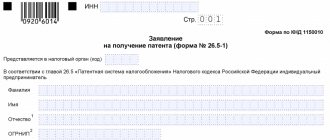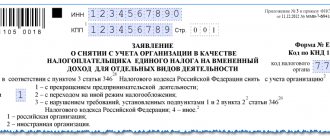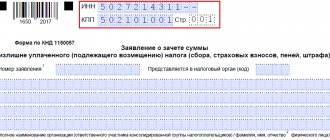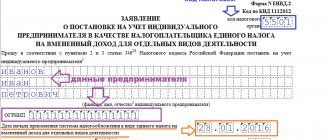What are the reasons for overpayments?
The circumstances in which organizations pay tax in excess of the required amount may vary. They can be caused by banal technical errors by specialists in the accounting department, overpayments on advance payments, incorrectly calculated tax base, etc. In such cases, enterprises have two options: either request a refund or write a statement about their offset.
An overpayment can be detected both by the taxpayer himself and by tax inspectors.
Offsetting is the most preferred option to resolve the problem of excessive tax transfers.
Taxes that can be offset
Not all types of tax payments can be adjusted in case of overpayment, and vice versa, not all types of payments can be redirected to this overpayment. The table shows the types of overpayments allowed for adjustment with the corresponding options for channeling funds.
| № | Type of tax overpayment | Where is it allowed to redirect money? |
| 1 | Federal taxation (overpayment of VAT, UTII, income tax, etc.) | To account for future payment of any federal tax, penalty or interest on such tax. |
| 2 | Regional taxation (transport tax, corporate property tax, etc.) | On account of future payment of the same tax or other regional fee, penalty, fine or arrears on regional taxes |
| 3 | Local taxes (land). | On account of the same tax or penalty. |
As you can see, re-offset of funds can only occur between taxes of the same level.
The nuance of redirecting for personal income tax
Income tax is calculated by the tax agent. Various rates apply to it, it is a direct payment, so there are certain subtleties regarding the return or credit for its overpayment. It cannot be carried out by the owner of these funds - the employee, but only by his employer as a tax agent, but by expressing the will of the employee - in a written statement. If an overpayment is revealed in relation to an already dismissed employee, this does not relieve the obligation to return it if the former employee so desires.
If the personal income tax return was submitted to the INFS by the taxpayer himself, for example, an individual entrepreneur, a re-offset or refund for the identified overpayment will be made by the inspectorate. In this case, the deadlines are calculated not from the submission of the application, but from the time the declaration is verified.
Overpayment control
The taxpayer is primarily interested in the correct payment of taxes and the absence of overpayments. Therefore, it is advisable to monitor the amount of funds paid to the budget and take action if an overpayment is detected.
If the fact of an overpayment is established not by the payer himself, but by the tax authorities during the audit, they must notify him of this within 10 days (working days, not calendar days).
IMPORTANT! If the payer has an arrears of a tax of the same level as the overpaid one, or a penalty or fine for a tax of the corresponding level, a refund of the overpayment is not possible, only a re-offset is carried out.
Title page
On the title page of the application, the taxpayer fills in all the necessary details, except for the section “To be completed by a tax authority employee”
.
"TIN" lines
and
“KPP”
are filled in automatically from the client’s registration card in the “SBIS” system. The page serial number is also filled in automatically.
In the "Application number"
The serial number of the application from the applicant for the current year is indicated.
In the field “Submitted to the tax authority (code)”
The code of the tax authority to which the application is submitted is reflected. This code is indicated in the documents on registration with the tax authority (certificate of registration with the tax authority, notice of registration with the tax authority of a legal entity as the largest taxpayer). By default, the field is automatically filled with the code that was specified when the client registered in the system.
In the field “Full name of the organization (responsible participant of the consolidated group of taxpayers) / last name, first name, patronymic of an individual”
the name of the organization is reflected, corresponding to that indicated in the constituent documents or the full name of the individual in accordance with the identity document.
In the “Based on article”
the number of the article of the Tax Code of the Russian Federation is selected, in accordance with which the offset is made.
In the field “Tax (calculation) period (code)”
The code of the tax (settlement) period is indicated in accordance with the established requirements:
- to fill in the first 2 digits of this indicator, select the appropriate code: “MS” - monthly, “QV” - quarterly, “PL” - semi-annual, “GD” - annual, “Date” - the specific date of tax payment;
- in the 4th and 5th digits of the indicator the following is indicated: month number (from 01 to 12) – for “MS”, quarter number (from 01 to 04) – for “KV”, half-year number (from 01 to 02) – for “PL”, for “GD” - “00”;
- The year is indicated in 7-10 digits.
In the “OKTMO code”
a code is selected for the place where the tax or fee is paid. You can find out your OKTMO code using the electronic services of the Federal Tax Service of Russia “Find out OK” (https://nalog.ru, section “All services”).
In the “Budget classification code”
The KBK of the tax or fee for which the overpayment is recorded is selected.
Attention! Each tax corresponds to one or more budget classification codes (BCC), depending on the payment attribute. So, for example, when choosing payment code “01”, the BCC of the tax is selected from the corresponding directory, the overpayment for which the applicant requests to be offset. If in relation to this tax it is necessary to offset excessively collected penalties, then when the payment code is changed from “01” to “04”, the BCC automatically changes, in particular, the value of 14-17 digits. The structure of the KBK is a 20-digit code, in which digits 1 to 20 mean the following:
- categories 1-3 – code of the department that controls the payment of the tax or fee (for example, “182” - Federal Tax Service);
- category 4 – income group code (for example, “1” - tax and non-tax income, “2” - gratuitous receipts);
- digits 5-6 – income subgroup code (for example, “01” - income tax, “02” - insurance premiums, etc.);
- categories 7-11 – code of article and sub-item of income;
- digits 12-13 – code of the income element (for example, “01” - federal budget, “06” - Pension Fund budget, etc.);
- categories 14-17 – code of the group of subtype of budget income (for example, “1000” - income group for income tax, “2100” - income group for penalties for income tax, “3000” - income group for fines for income tax and etc.);
- categories 18-20 – code of the analytical group of the subtype of budget revenue (for example, “110” - tax revenue, “120” - property income, etc.).
In the field “Code of the tax authority in which the overpaid (subject to reimbursement) amount is listed”
select the code of the tax authority in which the overpayment is recorded.
The credit type code is indicated in the appropriate field:
- “1” - to pay off arrears;
- “2” - for offset against future payments.
Fields “Tax (settlement) period (code)”
,
“The OK code
is filled in similarly only for the tax or fee against which the overpayment is offset.
Attention! Field “Code of the tax authority in which the arrears (debt) are listed”
is filled in in case of offset of overpaid tax to repay the arrears, i.e. when the credit type code “1” is selected.
In the field “The application is drawn up on ____ pages”
The number of pages on which the application is drawn up is automatically indicated.
In the section of the title page “I confirm the accuracy and completeness of the information:”
indicated:
- 1 - if the application is submitted by the taxpayer,
- 2 - if the application is submitted by a representative of the taxpayer.
In this case, the full name of the head of the organization or representative is indicated, as well as the name and details of the document confirming his authority.
In the "Phone"
The telephone number of the taxpayer or his representative is reflected.
The date is also automatically indicated on the title page.
The essence of the statement
The application is essentially an official application by an organization or individual entrepreneur to the state tax service for the right to realize the legitimate interests of the taxpayer. Tax authorities are obliged to consider this appeal and make the right decision on it.
It should be noted that if this statement is not made, tax officials have every right to independently distribute the overpaid amount of tax.
As a rule, the money is used to pay off various types of fines and penalties. That is why taxpayers are not recommended to delay filing an application, so that later they do not have to spend a long and painful time figuring out where the money went and whether it can be redirected or returned.
The period in which the money will be credited
Within ten days after receiving the application, tax specialists make a decision, which is drawn up in writing and brought to the attention of the taxpayer.
If it is positive, then within the time period established by law (usually no more than one month, but if we are talking about an updated declaration, then at least three) the money will be credited. They will go either to pay off penalties, arrears and fines, or to pay off some other mandatory payments - at the choice of the taxpayer.
The offset date will be considered the date the tax authorities made this decision.
What if they didn’t re-enroll?
Tax authorities are required to respond to a received application for redirection of funds for overpaid taxes. This response must be received in writing within 5 days - refusal or consent. If the taxpayer does not agree with the reasons for the refusal, he will have to appeal to the arbitration court.
If the positive option is delayed for more than a month, the organization is entitled to interest as a “penalty”. Each day of delay in repayment is additionally paid at the Central Bank refinancing rate, which was relevant at the time of filing the application. The rate is not divided by the actual number of days in the billing year, but by the conventionally accepted number 360.
Taxpayers are required to pay interest for the entire period of delay, even if the overpayment funds were later legally offset or returned.
Sample application for VAT refund by transfer to a bank account
Order of the Federal Tax Service of the Russian Federation dated February 14, 2017 No. ММВ-7-8/ [email protected] approved the application form for the refund of taxes, fees, insurance premiums, penalties and fines. From 01/09/2019, this form is used as amended by the Federal Tax Service order dated 11/30/2018 No. ММВ-7-8/ [email protected]
You can view this application and view a completed sample on our website.
VAT reimbursement has many nuances, which were discussed in detail by ConsultantPlus experts. Get trial access to the system for free and go to the Ready-made solution to find out the details of this procedure.
Features of the application, general points
The application has a standard unified form that is mandatory for use. When filling it out, you must adhere to certain standards that are established for all such documents submitted to government agencies.
Let's start with the fact that information can be entered into the form both on the computer and by hand. In the second case, you need to ensure that there are no blots, errors or corrections. If you couldn’t do without them, it’s better not to correct the form, but to fill out a new one.
The application must be signed by the applicant or his legal representative. A document must be stamped only if the rule for using stamps to certify outgoing documentation is specified in the company’s accounting documents.
It is recommended to write the application in two copies , identical in text and equivalent in law, one of which should be handed over to a tax authority specialist, the second, after putting a mark on acceptance, should be kept. In the future, this approach will avoid possible disagreements with the tax service.
Sample application for crediting the amount of overpaid tax
At the beginning of the document it is stated:
- addressee, i.e. the name and number of the tax office to which it will be transferred;
- name and details of the applicant - TIN, OGRN, address, etc. intelligence.
Next, the main part includes:
- request for tax credit;
- the type of tax for which the overpayment occurred;
- the type of payment against which it is required to be transferred;
- amount (in numbers and words);
- budget classification code (KBK);
- OKTMO code.
Finally, the document is dated and the applicant puts his signature on it.
How to submit an application
There are several ways to forward your application to the tax authorities:
- The simplest and most reliable is to go to the local tax office and give the application to the inspector in person, hand to hand.
- You can submit the application with a representative, for whom a duly certified power of attorney will be written.
- Send the application via Russian Post with a list of the contents by registered mail with acknowledgment of delivery.
- In recent years, due to the rapid development of electronic document management, sending documentation to government services via the Internet has become widespread. An application for offset of amounts of overpaid tax can also be sent in this way, but only on the condition that the company has an officially registered electronic digital signature.
How to offset tax overpayments
To offset the overpayment against future payments, submit an application to the inspectorate in the approved form (clause 4 of article 78 of the Tax Code of the Russian Federation).
Application for offset of tax overpayment sample
We recommend that you check your data with the tax authority before submitting an application to offset the overpayment. To do this, you can request a certificate of the status of settlements with the budget or a reconciliation report. The fact is that if the inspection reveals discrepancies with the amounts that you indicated in the application, it will still offer to carry out a reconciliation first.
If the overpayment arose due to an error in the declaration, then first submit an updated declaration in which the error was corrected (clause 1 of Article 81 of the Tax Code of the Russian Federation). After that, submit an application for credit. The inspectorate will offset the overpayment to pay off arrears of taxes (penalties, fines) independently.
However, you can submit an application for offset in this case yourself (clause 5 of Article 78 of the Tax Code of the Russian Federation).











